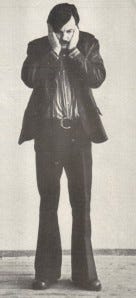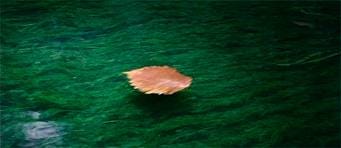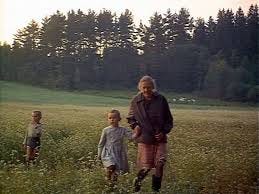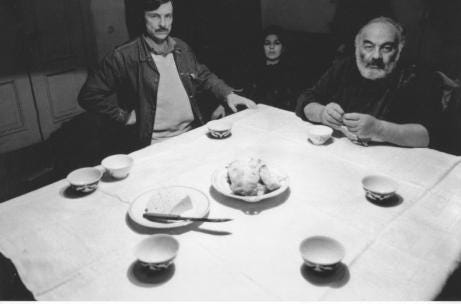From the archives — but following on from yesterday’s Scorsese-thoughts.
This post from my website had a long afterlife on Reddit. For some reason, it came to generate around 5% of my daily traffic.
There were a lot of people looking for reasons to watch or not watch Tarkovsky (my favourite film-maker). Someone even found it once with the search terms ‘how to watch stalker without getting bored’.
I agree with most of what I say here. And now that time has gone by, I can see that the thinking and watching and sitting doing nothing behind this was part of what led me to write my novel Patience, which begins with a very slow encounter with a white wall.
It’s undeniable: many people find Tarkovsky’s films uniquely boring. They also find them precious, pretentious, unendurably slow and finally mystifying – or just mystificatory.
Here’s one reviewer —
Um, if you were driven to distraction by the slow pace of 2001: A Space Odyssey, then you’ll be well advised to stay clear of this film. Solaris may not have an opening shot that is nearly ten minutes long (like The Sacrifice) but it comes pretty close to it. So if your taste in movies tends towards the let’s blow everything up to the accompaniment of a loud soundtrack like in Independence Day, then don’t even bother with Solaris.
That’s from scifimoviepage.com.
I would like to address this directly — Tarkovsky’s boredom; the boredom that some people find uniquely in Tarkovsky’s films. Not that I think I am addressing these people. Because you are at this conference, you are unlikely to find Tarkovsky objectionable in any major way. [This piece was first written for The Art of Andrei Tarkovsky symposium at Tate Modern, 9th May 2008.] You might say that you never find Tarkovsky’s films boring — and, ultimately, I would say this, too. There is a way that, for me, they are the most fascinating films ever made; at least, the final films — Nostalgia and The Sacrifice — are. But there is quite a long, slow way to go before I reach this point of total fascination – before the Stalker gets me to the Room.
To answer the question that I feel is now hovering in the room. ‘Did you ever personally ever find Tarkovsky’s films boring?’ – [Pause] – ‘Yes, I did.’ – However, it was boredom of a particular sort. When his scenes were long and slow, I was impatient for something to happen. To a greater extent, though, I was impatient with myself for becoming impatient. I got frustrated with how Tarkovsky was trying to do what he was trying to do. But I admired what he was trying to do almost without reservation.
I would like to begin by sharing with you the start of Solaris. It is my only clip.
Tarkovsky himself had reservations about Solaris – thought it a failure – and this, I think, is because it didn’t fit with his grandest project. The opening, however, is a demonstration of the way Tarkovsky addresses the screen itself. As you’re watching it, I’d like you to think about what this sequence is doing to you, and what it wants to do to you. Roll film.
You should watch from about 3.00 until 4.36. (Unless you just want to watch the whole thing). It’s here on YouTube.)
So, what did it do to you?
First of all, it slowed you down. There are events on the screen: initially, the reeds beneath the water establish a rhythm but our absorption in this is interrupted by the diagonal entrance and departure of a heroic leaf. I think it’s an elm or a birch leaf.
Then there are the camera moves, to which we almost immediately become extremely sensitised. They are, so far, all that we have of a developing story.
Secondly, the opening challenges your expectations. (Think of how each of the Star Wars films opens: the stars, a spaceship, a bigger spaceship, lasers.) You go into the cinema expecting — at the very least — to see something significant or amusing happen on the screen. The opening of Solaris functions in opposition to this: it forces you immediately to sit and wait for something to happen. Our expectations are reduced, so that smaller events — the leaf, the slow camera moves, a man scratching his head — are magnified.
Thirdly, I would say, and as an extension of the last point, the opening reconfigures the space of the screen itself. Rather than say, ‘Look, here is the screen, things happen on it.’ Tarkovsky says to the audience, ‘Look, here is the screen, if you watch it closely enough and for long enough, something may or may not happen on it.’
Lastly, in this reconfiguration of the screen, Tarkovsky changes it from a traditional projection-space into a field-of-possible-action. Yet the screen as field-of-possible-action isn’t something Tarkovsky is able to maintain throughout a film – although, I’d say, he secretly aspires to this.
If one was to track the ways in which this audience’s eyeballs moved, watching the opening shots of Solaris, I think you would find a great fragmentation of points of attention. Until the traverse of the leaf, we momentarily are looking around for something to look at. The same in the later, longer shot of the flowing reeds. We are, as viewers, a great deal freer than we are usually allowed to be in any cinematic presentation. (Awkward phrasing this, but I mean art installations as well as movies. Think of Gillian Wearing’s Sixty Minute Silence.)
Usually, our eyes are ping-ponged around in traditionally established ways. Whenever a human face is brought into vision, our gaze will flit between eyes and lips, remaining mainly on the eyes. When the rest of a human body is visible, we will explore it, always returning to the face and hands. When a group of people are on screen, we will — most of the time — look at the person speaking or the person whose reaction to the speech is most emotionally charged or, more simply, the one we fancy the most. Our glance here can also be controlled by the eye-movements of the people on screen. When a noise or voice comes from off-screen, we will attempt to look towards it. And then of course there is the enforced attention-switcher of the close-up.
But when relative emptiness and stillness fill the screen, or there is huge but undifferentiated complexity, or a face is held in view until we cease to perceive it as just a face, our eyes will first search for an obvious focus and then, if they do not find one, they will wander in expectation that a focus will soon appear. The promise of cinema remains: This is a screen, keep watching it, significant and amusing things will happen here.
These moments or minutes of eye-wandering are created more easily when the screen is empty of actors. But, I think, Tarkovsky very frequently wishes people in his audience to be offered the choice to look at different things within the visual field. In The Sacrifice he frequently has six or seven actors in view at once — avoiding close-ups almost completely. Even though one or other of them is usually speaking, they do so slowly, with pauses in-between, and we are at liberty to concentrate on whomever we find most fascinating. (Screwball comedy, it ain’t.) In this, Tarkovsky is more like a theatre director, for whom close-ups are unavailable.
When our gaze isn’t controlled, is allowed to wander, a different kind of tension is established — and it is one that many viewers find unbearable. And which, as a result, they would call boring. They would prefer to leave the cinema than to have to sit through a sequence such as the candle-carrying sequence in Nostalgia. And even those who know and love Tarkovsky’s work and methods will find themselves, from time to time, having to overcome anxiety, irritation, distraction and boredom.
I’d like to return, just for a while, to the idea of fields — agricultural fields and liberated visual fields. Both are a constant in Tarkovsky’s work. Remember the final shot of Mirror (from 1:40:14) — the camera retreating into the forest, away from the familiar field.
There is a remarkable sequence in the documentary Tempo di Viaggio, Time of a Journey. Tarkovsky has been asked what he’ll do when he returns to Russia.
‘I’ll try to go to the village right away,’ he says. ‘I miss the village. Larissa and I bought a little house there to spend most of our time, but unfortunately it’s not working out. Half a year, about eight months… It was the first time I’ve ever lived in a village without going away, permanently. And I saw the whole cycle of this life. I was astonished, because I saw that in the same place the nature…’ [He breaks off, unable to complete the thought expressing it this way.] ‘I was in a hurry in the beginning. I thought I was missing some important things in Moscow; that I should go, catch up with someone. Now, I live on this land.’ [Here Tarkovsky is re-enacting the movement of his own work, from impatient searching for visions to a more passive acceptance of what passes before us. And this is how he describes what he finds – ] ‘Now, I live on this land. There are many beautiful fields, around our village, many fields.’ [There aren’t many people, especially film directors, who would talk about beautiful fields – views, trees, buildings, yes; fields, no.] ‘And very beautiful land, especially when cultivated. When the wheat blooms, there are many white flowers. In the dark it looks like fog on the ground. It is difficult to tell whether it is fog or flowers. It is a very beautiful view. Beautiful soil. Wet soil is violet. Dry soil makes a noise when you walk on it.’
There is a second characteristic of Tarkovsky’s eye-freedom here: the deliberate uncertainty — ‘It is difficult to tell whether it is fog or flowers’, mirror or direct view, shadow or shape, water or glass. This is Tarkovsky’s visual signature — or one of them. But I would like to remain with the fields.
In the documentary Directed by Andrei Tarkovsky, also based around the making of Nostalgia, Tarkovsky says, ‘I have a contemplative relationship with reality.’ This, I’d say, is the kind of relationship he tries to encourage his viewers to have with his own images.
One thing about them is that they are often fields we are allowed to explore in our own way; a second thing, equally significant, is that we are allowed to explore them in our own time.
This is a crucial point. Tarkovsky’s films are slow because he very often leaves things on the screen long enough for us not just to see them but to contemplate them – and not only this, but long enough for us to lapse from contemplating them, realise this, and return to contemplating them for a second, third or a fourth time.
Again, many people find this ‘boring’ – and here I begin to introduce inverted commas around the word boring – because they have got the image on first viewing. ‘I know what it is,’ they think. ‘It’s an empty field. Next.’
Because Tarkovsky’s films are slow, the easiest way to shorthand them is to say that they are meditative. This, obviously, doesn’t go anywhere near far enough. They are themselves Tarkovsky’s own meditations. But, even more so, they offer themselves up as objects of meditation for us.
And as with meditation, particularly the Zen Buddhist practise of zazen or ‘just sitting’, the failures of consciousness are just as important as the moments when consciousness is stilled or transcended.
Tarkovsky’s liberated visual fields allow and encourage lapses of attention. A second looking overwhelms the first, and is itself — after a break — usurped by a third. Even as we watch it, we have the time to re-view the film. And at a certain point, we start to look at our own looking. Obviously, the films have narratives which draw us onwards. But we aren’t expected to be constantly entertained. Instead, we return to the film repeatedly, re-committing ourselves to watching it to the end.
An aside here about DVDs. Although they allow us to see what Tarkovsky’s films look like, just as MP3s allow us to hear what an album sounds like, they are not Tarkovsky’s films. Tarkovsky’s films only exist as cinematic presentations.
More, I’d say, than any other filmmaker, his films require us to be brought together, isolated in a common dark.
I hope I have gone some way to explaining how I see Tarkovsky’s boredom as working. I’d now like to finish by giving a short explanation as to why he made his films this way.
In the documentary Directed by Andrei Tarkovsky, Tarkovsky says straight out, ‘The purpose of art is to help man improve himself spiritually.’
Now, it’s very easy to dismiss this as typically vague pseudo-profound statement of the sort to which Russians are given. However, I think Tarkovsky meant exactly what he said, and meant it on this level – that every single frame of his films should, in and of itself, help man to improve himself spiritually.
As Rashit Safiullin, Production Designer of Stalker said, ‘With him, there had to be not a single unmotivated flower in the frame…’
In order to make this improving kind of film, the director has himself to be spiritually as pure as possible. In Tempo di Viaggio, Tarkovsky makes the most extraordinary statement I’ve ever heard a film-maker come out with. He is on a sun-hazy balcony belonging to Tonino Guerra, scriptwriter of Nostalgia. Tonino Guerra is relaying some questions that have been sent in, as letters. One comes from a film student, and is bland enough: ‘What advice would you give to young directors?’ To which Tarkovsky, haggardly thin, says that too many directors ‘take their work as a special position, given to them by destiny, and simply exploit their profession. That is, they live in one way but make movies about something else. And I’d like to tell directors, especially young ones, that they should be morally responsible for what they do while making their films.’
Contrast this to the attitude of most wannabe directors, who see popular success as their ticket to Fellini-world. Tarkovsky’s is a very extreme position to take: that what happens off-screen will be part of the ultimate meaning of a film. The proof of his assertion, though, working backwards, is that Tarkovsky’s own films are more spiritually progressive than any movies ever produced by Hollywood. (This is an argue-late-into-the-night point.)
Tarkovsky’s films make a virtue — literally — of the very, very long shot. Perhaps the most famous of these comes in Nostalgia. For eight minutes forty-one seconds an ailing man in a heavy overcoat attempts to carry a lit candle from one end of a drained, misty Roman Baths to another. He fails, repeatedly; three times the candle blows out — three times the man has to return to his start-point, relight the candle and set out again in uncertainty. It is Buster Keaton redone as Existentialism.
What we have in this scene is clearly and unmistakably a very simple and beautiful but also painful metaphor for all human struggles — especially spiritual ones. In fact, the metaphor is so blatant that, at moments, I am almost embarrassed to watch — even though, and here’s the thing, I know that on the fourth attempt the man will succeed in reaching the far end.
Admit it, some of you are relieved I won’t be showing this scene.
I quite understand why many if not most people would object to this kind of film-making, and would prefer to head for the multiplex and its fast-cut eye-candy. But because they do not permit lapses of attention, such films are — on Tarkovsky’s terms — bound to be spiritually void. (Not to mention that they are probably made by individuals as morally corrupt and spiritually bankrupt as their pay packets and drug habits permit them to be.)
The people who are patient enough to sit through Tarkovsky’s films are patient people. They are, I’d argue, very likely to be better people than those who walk out or reject this kind of cinema entirely; more considerate, more capable of self-control, less quick to anger, less manipulable by bright lights and loud bangs. What they try to achieve is a similar effect to meditation.
Even if this is not true, I think it comes close to what Tarkovsky believed — his grandest project. And by being so utterly out of step with our times, it reveals these times all the more vividly. They are, in their hyperactive way, very boring times indeed.









Thank you for this thoughtful exploration of what is required of someone watching a film by Tarkovsky. I love his films for exactly these reasons.